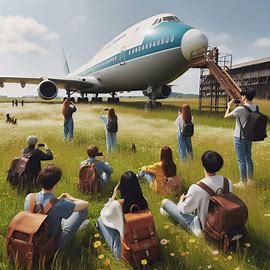
Introduction
Every aircraft has a lifespan. While most of their working years are spent soaring through the skies carrying passengers or cargo, there comes a time when airlines must retire these mechanical marvels. But what happens when a commercial aircraft retires? This article explores the multifaceted journey of aircraft retirement — from storage and parting out to upcycling, recycling, and even preservation in museums.
Understanding the full lifecycle of commercial jets helps appreciate not only their engineering but also the critical environmental and economic implications of how they are retired.
1. Reasons Behind Aircraft Retirement
1.1 Economic and Operational Considerations
Aircraft are typically retired when they become financially unviable or technologically outdated. Airlines evaluate maintenance costs, fuel efficiency, and availability of newer models before making the retirement call.
Key factors include:
- Rising maintenance costs with age
- Decreased fuel efficiency compared to newer aircraft
- Regulatory changes affecting noise and emissions
- Market downturns (e.g., during COVID-19)
1.2 Technological Advancements and Environmental Regulations
Modern aircraft offer better avionics, reduced fuel consumption, and improved safety features. At the same time, stricter environmental rules push older models out of active service.
Examples:
- Boeing 727 retired largely due to noise restrictions
- Older 747 models phased out for being fuel-guzzlers
2. Aircraft Storage: The First Stop Post-Retirement
2.1 Aircraft Graveyards and Long-Term Parking
Once retired, aircraft are typically flown to storage facilities or boneyards located in dry desert climates, such as:
- Mojave Air and Space Port (USA)
- Pinal Airpark (USA)
- Alice Springs (Australia)
Dry climates prevent corrosion and help preserve aircraft structure.
Storage types:
- Short-term: Ready for reactivation
- Long-term: Preserved but not expected to fly again
- Part-out: Awaiting dismantling
2.2 Maintenance While in Storage
Even in retirement, aircraft require maintenance. Technicians regularly check systems to:
- Prevent system degradation
- Maintain tire pressure and hydraulic levels
- Ensure security and weatherproofing
| Storage Type | Reactivation Time | Maintenance Intensity |
|---|---|---|
| Short-term | Weeks to months | High |
| Long-term | 6+ months | Medium |
| Part-out | Not applicable | Low |
3. Aircraft Dismantling and Parting Out
3.1 Valuable Components Salvaged
Aircraft don’t go to waste when retired. Many components hold significant value and are removed for resale:
Salvaged parts include:
- Engines
- Avionics systems
- Landing gear
- Auxiliary Power Units (APUs)
- Flight control surfaces
3.2 Aircraft Teardown Process
The teardown process is systematic and governed by strict safety and environmental protocols.
Steps include:
- Deactivation of systems and fuel drainage
- Removal of hazardous materials
- Dismantling of key components
- Sorting for resale, recycling, or disposal
Certified companies specialize in aircraft dismantling and comply with regulations from FAA, EASA, and ICAO.
4. Recycling and Environmental Responsibility
4.1 Aircraft Recycling Initiatives
Over 80% of an aircraft’s weight can be recycled. Organizations like AFRA (Aircraft Fleet Recycling Association) ensure eco-friendly practices.
Recyclable materials:
- Aluminum (fuselage, wings)
- Composites (interior panels)
- Titanium and steel (engine parts)
- Copper (wiring)
Environmental benefits:
- Reduces landfill waste
- Cuts demand for raw material extraction
- Lowers carbon footprint
4.2 Upcycling and Creative Reuse
Some aircraft parts are turned into:
- Furniture (wing desks, turbine lamps)
- Art installations
- Luxury homes or restaurants (e.g., Jumbo Stay in Sweden)
| Component | New Use Example |
| Wing section | Dining table |
| Cabin windows | Picture frames |
| Fuselage shell | Boutique hotel or cafe wall |
5. Aircraft in Museums and Educational Use
5.1 Historic Preservation
Not all retired aircraft end up in pieces. Many are preserved in museums or aviation parks.
Famous examples:
- Concorde displayed at Musée de l’Air (France)
- Boeing 747 at The Museum of Flight (Seattle)
Preserved aircraft serve as educational tools and honor aviation milestones.
5.2 Flight Simulators and Training Aids
Retired cockpits and cabins often find new life in aviation training schools:
- Pilot training simulators
- Cabin crew emergency procedure practice
- Aircraft rescue firefighting drills (ARFF)
Organizations benefiting include:
- Flight schools
- Maintenance academies
- Emergency response teams
6. Return to Service or Secondary Use
6.1 Cargo Conversion
Some aircraft find new life after retirement as cargo freighters. This is common with:
- Boeing 737, 757, and 767 series
- Airbus A320 and A321
Advantages:
- Cost-effective compared to new freighters
- Extends aircraft life by 10–20 years
6.2 Charter and Humanitarian Use
Older jets may serve:
- Charter flights
- Medical evacuations
- Disaster relief transport
These secondary uses allow airlines and governments to extract additional value while serving humanitarian needs.
| Secondary Use | Common Aircraft Models |
| Cargo conversion | Boeing 737, A321 |
| Humanitarian | DC-10, A310 |
Conclusion: Life After the Final Flight
So, what happens when a commercial aircraft retires? Retirement isn’t the end—it’s a transition into multiple new forms. Whether disassembled for parts, converted into freighters, upcycled into homes, or placed in a museum, each retired aircraft contributes to a broader aviation ecosystem.
As sustainability becomes central to aviation, aircraft retirement processes will only grow more innovative and eco-conscious.